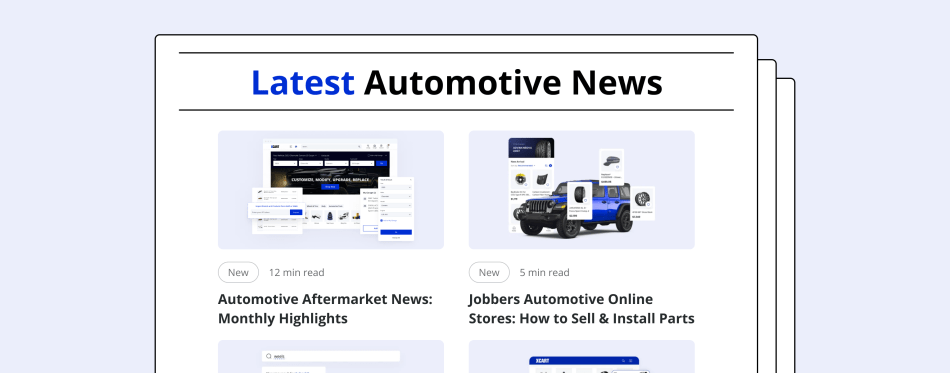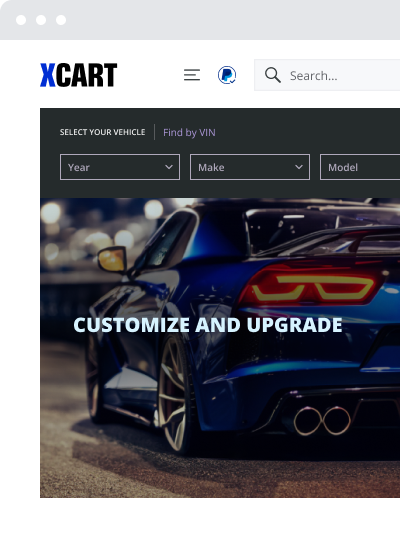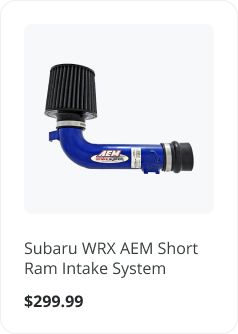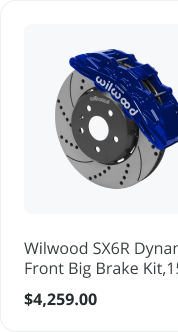D2C eCommerce Tools for Auto Parts Manufacturers
A car owner needs a replacement part and orders it directly from the manufacturer, receiving it in days instead of waiting weeks. This convenience is the promise of Direct-to-Consumer (D2C) eCommerce. For auto parts manufacturers, direct-to-consumer isn’t a trend anymore because 43% of Gen Z buyers prefer to shop directly from them. This happens because younger generations seek transparency and trust from sellers.
Brands also benefit from direct sales. Without middlemen, manufacturers boost profits and attract new loyal customers. However, the D2C eCommerce business model comes with challenges like managing inventories, building an online shop, ensuring fitment accuracy, and competing with traditional retail channels like Amazon, which owns over 12% of the online auto parts market in a single quarter.
The good news is that modern eCommerce is flexible. It allows manufacturers to start selling in weeks without expensive development and design. Plus, many platforms offer automation features that relieve auto parts inventory management. Read on to learn everything about going online as an auto parts manufacturer.
What Is D2C eCommerce and Why Does it Matter for Auto Parts Manufacturers?
D2C eCommerce is a business model in which brands sell auto parts directly to customers through online platforms, skipping retailers and distributors. Unlike B2C (Business-to-Consumer), where retailers sell auto parts to customers, the direct-to-consumer approach gives manufacturers full control over pricing, branding, and customer relationships.
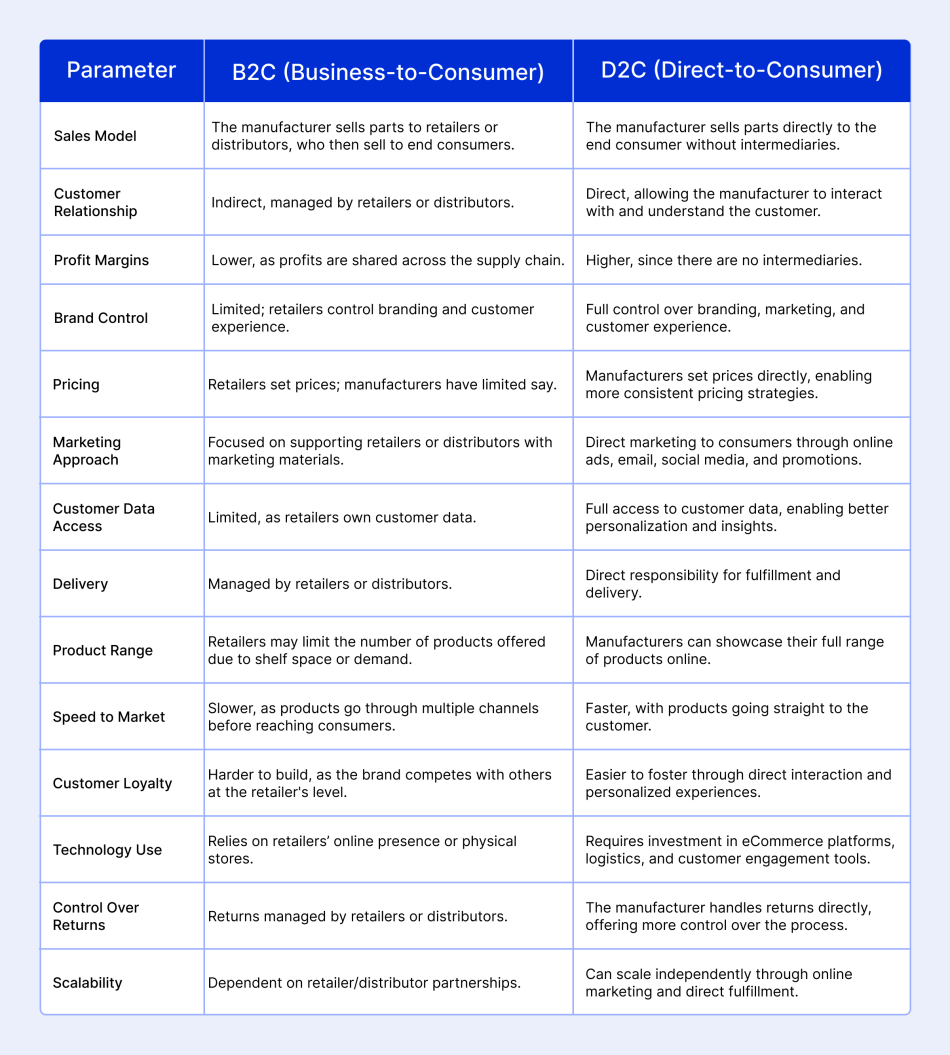
For example, Tesla’s online shop is a successful direct-to-consumer model in the automotive industry. Tesla offers everything from car accessories to apparel directly to customers. Brands like Nike in retail and Dell in tech also cut out middlemen and focus on direct sales.
The auto parts market, including OEM and aftermarket parts, is massive. In 2023, the automotive OEM market alone was worth $35 billion. Direct-to-consumer is perfect for auto parts manufacturers because it offers higher profit margins, good direct relationships with car owners, and better control of the shopping experience. With D2C eCommerce, manufacturers can create brand loyalty programs, offer personalized customer services, and maintain their brand image independently.
OEM vs. Aftermarket – What Auto Parts Manufacturers Need to Know
OEM (Original Equipment Manufacturer) automotive parts are made by the same company that produces the original components for a vehicle. For example, a brake pad labeled as OEM for Ford is identical to the one installed at the factory. An OEM buyer or user typically looks for parts that perfectly match their vehicle’s original specifications.
On the other hand, aftermarket auto parts manufacturers produce parts that fit multiple vehicle brands or models. They often cost less and may offer more variety, but quality and fitment can vary widely.
So, which is better?
OEM parts guarantee compatibility and reliability. They are ideal for users who seek high-quality parts. However, aftermarket parts are sometimes better if they offer enhanced features, such as higher durability or performance, at affordable prices.
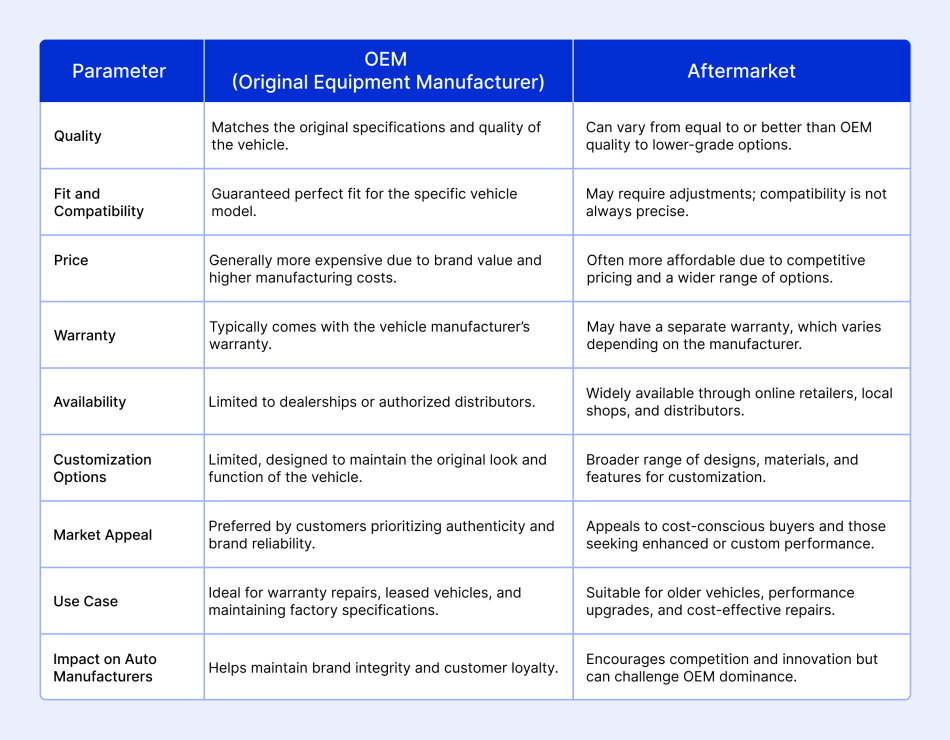
As you can see, there is a sustainable demand for original and aftermarket parts. Moreover, younger generations buy from manufacturers, avoiding potential hassles with incompatible or low-quality parts. Today is a good time to adopt a direct-to-consumer model, but there are a few things you need to keep in mind before launch.
Challenges of Direct-to-Consumer Sales
Selling auto parts online can be challenging. Managing massive inventories of parts can become overwhelming. Imagine tracking thousands of parts for different models and years.
Fitment accuracy is another issue. If a customer orders a part that doesn’t fit their car, it leads to returns and lost trust. For example, a small error in listing a tire size can cause major issues.
“With industry-standard databases preloaded, we’ve made it simple for our users. Parts align with the latest fitment data automatically for higher accuracy and reduced errors by up to 90%.”
Then there’s the competition. Giants like Amazon and eBay Motors dominate the market. They offer convenience and competitive pricing. Standing out requires more than good products— the best online store experience for car owners.
Other biggest challenges include complex logistics and the need for upfront investment in technology and infrastructure. The initial investment in direct-to-consumer infrastructure can be offset by its higher margins and increased control in the long run.
Finally, as your store grows, you must handle more orders, maintain accurate product pages, and provide fast, reliable support. Without the right tools, these challenges can slow growth and frustrate customers.
How Auto Parts Manufacturers Can Go Online
Going digital doesn’t have to be a long, complicated process for auto parts manufacturers looking to enter the online market. With the right tools, they can build their online presence, reach more customers, and increase sales regardless of lower dealer prices.
How Borgeson Boosted Sales by 10% Regardless of Lower Dealer Prices
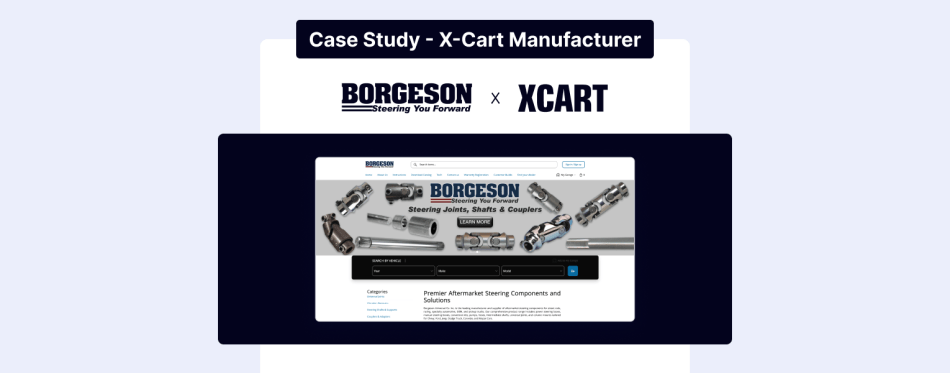
Looking for a similar experience?
First, you need to choose a scalable, easy-to-implement eCommerce solution that offers customizable automotive templates and automated stock management. This way, you can set up your first store in weeks, not months, and start selling parts immediately.
Integration with marketplaces like Amazon, eBay Motors, and Google Shopping will expand the reach of car owners. By centralizing all sales channels in one hub, manufacturers can manage orders and provide excellent customer service.
Accurate data automation tools that sync with trusted warehouse distributors and automotive catalog providers and comply with ACES and PIES standards are a must. These tools will always keep the product listings up to date, and advanced fitment tools will guarantee the right parts are delivered.
Are you unsure if this model will yield tangible results? Let’s examine the benefits of going D2C for auto parts manufacturers.
Key Tools for Successful D2C eCommerce for Auto Parts
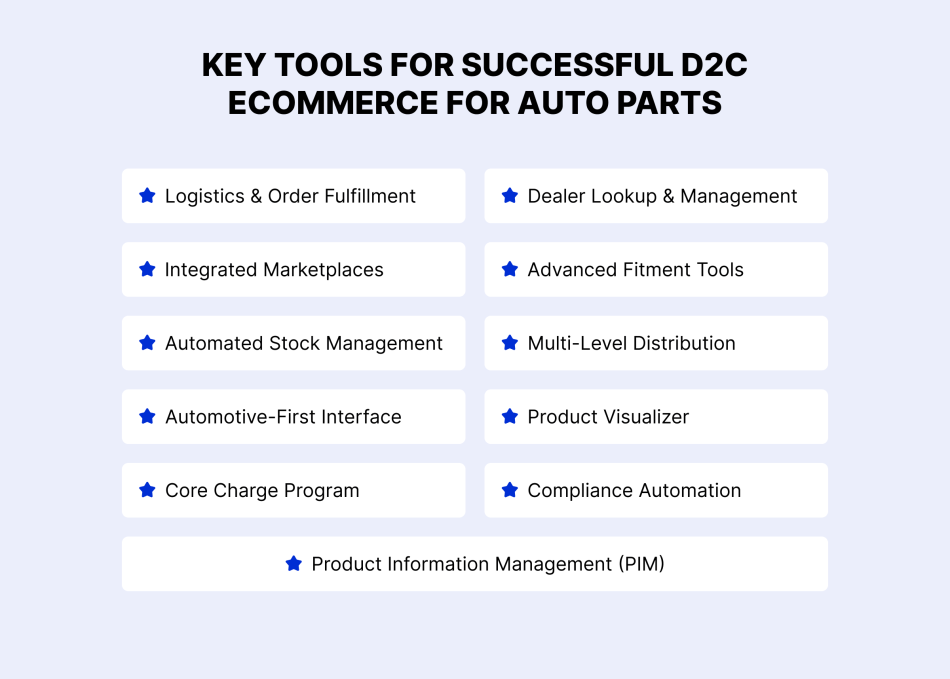
Again, your online shop starts with the right automotive eCommerce platform. It should be easy to customize, grow with your business, and integrate with your warehouse distributors and catalog providers. Tools like X-Cart offer functionalities tailored to auto parts sellers. They integrate with key suppliers and automate inventory, pricing, and orders.
Here are the key tools you’ll need built into the eCommerce platform of your choice:
Logistics and Order Fulfillment Process
Fast shipping and good stock tracking are things that your automotive eCommerce platform needs to offer, too. Look for partnerships with FedEx, USPS, or DHL for quick deliveries, and use warehouse management tools to avoid running out of inventory.
Dealer Lookup and Management
Your eCommerce platform should make it easy to find and manage dealers. This includes importing, exporting, and organizing dealer information to expand your network.
Integrated Marketplaces
Look for platforms that allow you to manage orders from Amazon, eBay Motors, and Google Shopping in one place. SEO-friendly listings are also important for organic search, as they boost visibility across multiple channels and support your digital marketing strategies.
Compliance Automation
A reliable platform will be ACES and PIES compliant, with integrations like SEMA Data. It will allow you to automate product updates, reduce manual errors, and keep customer data safe.
Advanced Fitment Tools
Your ideal online shop will let users search parts by year, make, model, engine type, VIN, bolt patterns, and other tiniest details and add vehicles to My Garage. It’s essential for a perfect fit and fewer returns.
Automated Stock Management
Look for inbuilt automated imports and updates from suppliers like Wheel Pros and Meyer Distributing. Such a feature helps keep stock levels and pricing always up-to-date. Flexible pricing keeps margins safe and offers great deals at the same time.
Product Information Management (PIM)
The platform should allow you to pull accurate data from SEMA Data, ASAP Network, and AutoSync to keep your catalog compliant and error-free. It should also automate product listings with scheduled updates, category mapping, and real-time stock and price syncs.
Multi-Level Distribution
Integrating with distributors like Turn 14 Distribution, Keystone Automotive, and Meyer Distributing will improve product availability. The right platform will allow you to sync orders and inventory directly with suppliers, enabling multi-level distribution management.
Automotive-First Interface
A good automotive D2C eCommerce comes with an automotive-first UX that allows users to find the right fit from the first lookup by year, make, model, engine type, and more. It is intuitive for car owners at every stage of the customer journey: payment, shipping, and invoice management in one place. Look for mobile-friendly themes to give the best experience on any device.
Product Visualizer
With the product visualization tools, customers can virtually try auto parts like wheels and tires on their cars. This is another effective feature for dealing with high returns and low customer confidence.
Core Charge Program
Finally, you can offer refunds for returned old parts to encourage sustainability. It’s a win-win for the environment, customers, and you.
Why Direct-to-Consumer Works for Auto Parts Buyers
Direct-to-consumer offers major advantages for car owners. First and foremost, accurate fitment tools reduce returns, which is a major global commerce issue. And customers don’t want to cover the costs. Nearly 88% of consumers say they stopped shopping with a company because of the paid returns policy.
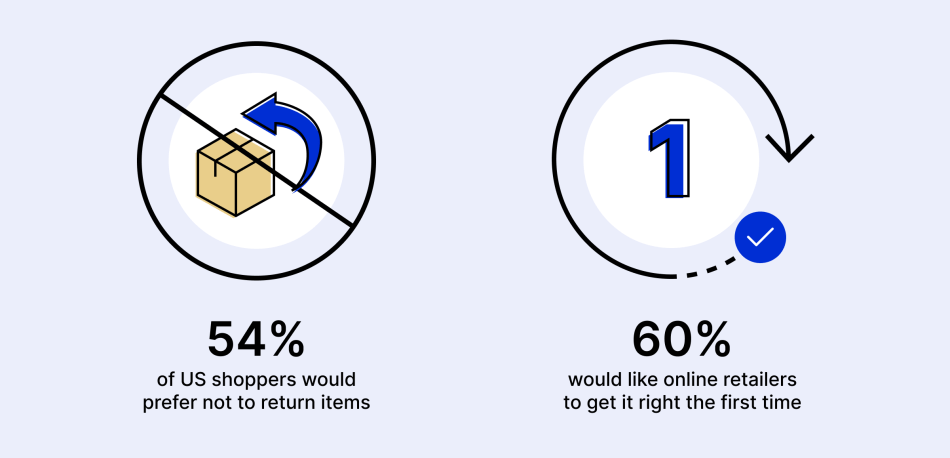
Direct engagement with parts manufacturers also creates greater transparency. Car owners can ask questions, learn about product features, and receive personalized recommendations from the original producer.
So, what’s the ultimate car owner experience? It’s the peace of mind knowing that every part ordered is the perfect fit, delivered quickly and hassle-free, and supported by the people who know the product best.
Conclusion
Auto parts manufacturers should seriously consider investing in a scalable, automated automotive eCommerce platform to uncover all the profit-boosting opportunities. On top of the profits, they will get improved customer relationships and more control over their brand and operations.
X-Cart platform is the solution to the challenges discussed in this blog. It offers tools for accurate fitment, automated inventory, and integration with major marketplaces.
Whether you’re an OEM or aftermarket manufacturer, there are target customers for the auto parts you produce and the direct purchasing from your company. Ready to go digital with your auto parts? Explore our platform today to see how we can help you with direct-to-consumer auto parts eCommerce.
Don’t wait–go to online market as a manufacturer within weeks!
About the author





